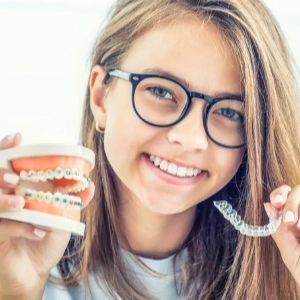Orthodontic treatment has evolved significantly over the past few years, offering teenagers more options than ever to achieve a straighter smile. Among the most popular choices are Invisalign Teen vs traditional braces. Let's delve into the advantages and disadvantages of each to help you make an informed decision for your teen's orthodontic care.
Invisalign Teen utilizes clear aligners made of smooth, comfortable plastic that gradually shifts teeth into the desired position. These aligners are custom-made to fit over the teeth and are virtually invisible.

Traditional braces have metal brackets attached to the teeth, connected by wires and elastic bands. They apply constant pressure to gradually move teeth into alignment.
Invisalign Teen is effective for mild to moderate orthodontic issues, while traditional braces can address more complex problems.
Invisalign Teen offers a more discreet option, while traditional braces are more visible.
Invisalign Teen is generally more comfortable since it lacks metal components.
Treatment duration depends on individual needs but may be shorter with traditional braces in some cases.
The cost typically falls between $3,000 and $7,000 for both Invisalign and traditional braces.
With Invisalign, maintaining oral hygiene is simpler since the aligners can be removed, allowing for easy brushing and minimizing plaque buildup. In contrast, braces can trap plaque and bacteria around and under the brackets, posing challenges for effective brushing and flossing.
Invisalign Teen requires consistent wear and proper cleaning, while traditional braces demand diligent oral hygiene practices.

Consider the severity of your teen's dental issues. Invisalign Teen is best for mild to moderate cases, while traditional braces suit severe problems.
Assess your teen's activities. Invisalign Teen's removability is ideal for active lifestyles. Traditional braces might be challenging for sports or playing instruments.
Discuss options with your teen. Some prefer Invisalign Teen's discreet appearance, while others like customizing traditional braces.
Get expert advice. An orthodontist can evaluate your teen's dental health and suggest the most suitable treatment option based on their assessment.
Both Invisalign Teen and traditional braces offer unique benefits and considerations. By weighing the" Invisalign Teen vs. Traditional Braces: Pros and Cons, you can make a well-informed decision that aligns with your teen's needs and preferences. This thoughtful decision-making process will contribute to fostering a sense of confidence and well-being, culminating in a radiant and healthy smile for your teen.
At the end of the day, both Invisalign Teen and braces are found to be effective at straightening teeth. To decide between the two, speak with our dentist at Invisalign- Toronto in Front Street West, Toronto, ON, about which option may be the better fit for you or your child's smile.
If you're ready to take the next step in getting braces or aligners for your child, book an orthodontic consultation online, or new patients can call us at (647) 931-2983. All Other Callers can reach out to us at (416) 551-4401.
The cost of Invisalign Teen and traditional braces can vary based on factors such as treatment complexity and location.
While Invisalign Teen is effective for many orthodontic issues, severe cases may require traditional braces for optimal results.
Invisalign Teen is designed for adolescents and teenagers with developing dentition.
Invisalign Teen aligners should be worn for 20-22 hours per day for optimal results.
Yes, traditional braces can be customized with colorful rubber bands to suit your teen's preferences.